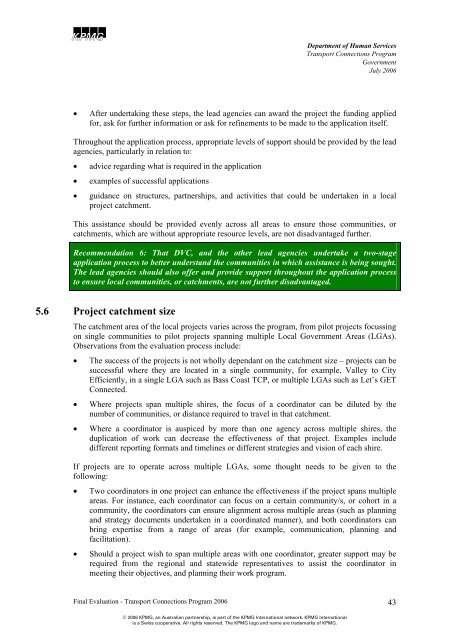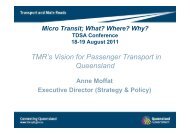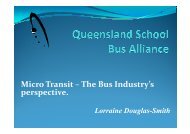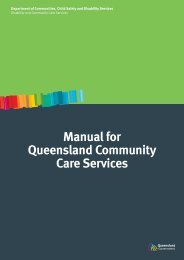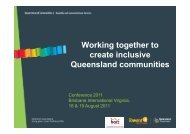Transport Connections Evaluation Report - TDSA
Transport Connections Evaluation Report - TDSA
Transport Connections Evaluation Report - TDSA
You also want an ePaper? Increase the reach of your titles
YUMPU automatically turns print PDFs into web optimized ePapers that Google loves.
ABCD<br />
Department of Human Services<br />
<strong>Transport</strong> <strong>Connections</strong> Program<br />
Government<br />
July 2006<br />
• After undertaking these steps, the lead agencies can award the project the funding applied<br />
for, ask for further information or ask for refinements to be made to the application itself.<br />
Throughout the application process, appropriate levels of support should be provided by the lead<br />
agencies, particularly in relation to:<br />
• advice regarding what is required in the application<br />
• examples of successful applications<br />
• guidance on structures, partnerships, and activities that could be undertaken in a local<br />
project catchment.<br />
This assistance should be provided evenly across all areas to ensure those communities, or<br />
catchments, which are without appropriate resource levels, are not disadvantaged further.<br />
Recommendation 6: That DVC, and the other lead agencies undertake a two-stage<br />
application process to better understand the communities in which assistance is being sought.<br />
The lead agencies should also offer and provide support throughout the application process<br />
to ensure local communities, or catchments, are not further disadvantaged.<br />
5.6 Project catchment size<br />
The catchment area of the local projects varies across the program, from pilot projects focussing<br />
on single communities to pilot projects spanning multiple Local Government Areas (LGAs).<br />
Observations from the evaluation process include:<br />
• The success of the projects is not wholly dependant on the catchment size – projects can be<br />
successful where they are located in a single community, for example, Valley to City<br />
Efficiently, in a single LGA such as Bass Coast TCP, or multiple LGAs such as Let’s GET<br />
Connected.<br />
• Where projects span multiple shires, the focus of a coordinator can be diluted by the<br />
number of communities, or distance required to travel in that catchment.<br />
• Where a coordinator is auspiced by more than one agency across multiple shires, the<br />
duplication of work can decrease the effectiveness of that project. Examples include<br />
different reporting formats and timelines or different strategies and vision of each shire.<br />
If projects are to operate across multiple LGAs, some thought needs to be given to the<br />
following:<br />
• Two coordinators in one project can enhance the effectiveness if the project spans multiple<br />
areas. For instance, each coordinator can focus on a certain community/s, or cohort in a<br />
community, the coordinators can ensure alignment across multiple areas (such as planning<br />
and strategy documents undertaken in a coordinated manner), and both coordinators can<br />
bring expertise from a range of areas (for example, communication, planning and<br />
facilitation).<br />
• Should a project wish to span multiple areas with one coordinator, greater support may be<br />
required from the regional and statewide representatives to assist the coordinator in<br />
meeting their objectives, and planning their work program.<br />
Final <strong>Evaluation</strong> - <strong>Transport</strong> <strong>Connections</strong> Program 2006<br />
43<br />
© 2006 KPMG, an Australian partnership, is part of the KPMG International network. KPMG International<br />
is a Swiss cooperative. All rights reserved. The KPMG logo and name are trademarks of KPMG.


